From Blueprint to Build: How to Operationalize Your Content Strategy
Most content strategies fail in execution, not intent. At Relato, we help content teams close the gap between strategy and delivery with purpose-built workflows and smarter briefs. This article shares proven practices from leading teams that know how to scale production without sacrificing quality.

You had a solid strategy. The kickoff call went well.
Messaging? Aligned. Content pillars? Approved. Even sales was on board.
Now it’s launch week… and everything’s stalled.
The blog’s stuck in review. The case study brief was never written. And someone just asked if the webinar slides are on brand, which is a sure sign they never saw the brand guidelines you shared weeks ago.
Sound familiar?
Chelsea Castle, Head of Content and Brand at CRM platform Close, sees this pattern across teams:
"Every single team I've ever joined is always reactive. When I talk to friends at other companies, their content teams don't have their own strategies either. They're just creating whatever everyone else in the organization says they should create."
“Every single team I've ever joined is always reactive. When I talk to friends at other companies, their content teams don't have their own strategies either. They're just creating whatever everyone else in the organization says they should create.”
Here's what's happening: teams nail the what but struggle with the how. They can outline quarterly themes, but they struggle to turn them into actionable briefs, clear timelines, and content that ships on schedule.
To see how high-performing teams close this gap, we spoke with Chelsea and other content leaders who’ve figured out how to grow content production without sacrificing quality or burning out their teams. Those content leaders include:
- Sam Balter, Head of Content at video marketing platform Wistia
- Kasey Steinbrinck, Senior Marketing Manager at communications platform Sinch
- Jennifer Clark, Content Marketing Lead at Zoom
- Janine Anderson, Content Operations Manager at Zapier
This piece won't ask you to rethink your whole approach. We'll focus on building the system that gets your existing strategy out the door.
Why strategy fails without operations
Strategy without execution is just an expensive PowerPoint. If there's no process to move content from idea to publish, your plan stays theoretical.
You’re not alone. Nearly 43% of content marketers cite lack of strategy as a core non-content creation challenge according to The State of (Dis)Content report. Even teams with clear goals often lack the systems to turn those goals into action.
Here's where teams typically break down.
The brief doesn’t reflect the strategy
Your content strategy might target enterprise buyers with thought leadership, but your brief says, “800-word blog post about our new feature.”
Without a clear link between high-level goals and individual assignments, writers end up guessing whether they’re supposed to drive leads, awareness, or credibility. They might hit the word count but misalign on tone, audience, or intent.
You see the results in surface-level case studies, whitepapers that sidestep real customer pain points, and social posts that feel off-brand. When briefs aren’t grounded in strategy, content meets requirements but fails to influence pipeline, shape buyer perception, or support revenue goals.
At Relato, every brief includes a clear purpose section that connects the individual piece to broader campaign goals, so writers understand exactly what they're trying to accomplish.
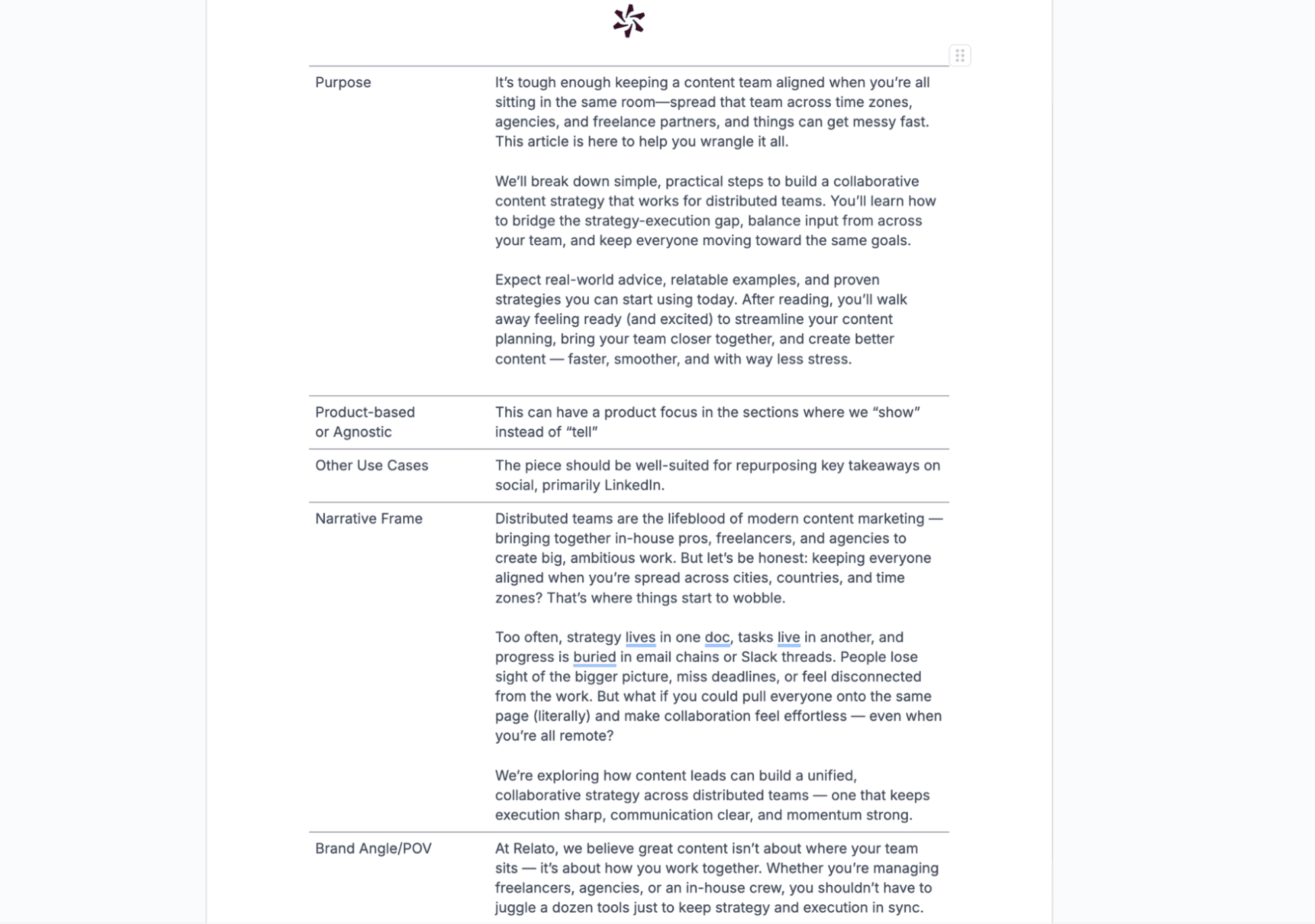
Tip: Check out our content brief template to see how we structure this connection between strategy and execution.
The content calendar is missing deadlines or owners
A calendar with topics but no assigned owners or firm deadlines isn’t a plan. It’s a wish list. And when deadlines shift without updates to reviews or dependencies, momentum stalls and confusion spreads.
Sam Balter, Head of Content at Wistia, sees this happen when process overtakes purpose: "I look to see when our process is sucking the fun out of everything. When a project becomes more about how it will be documented vs. what we are actually trying to say, I know the process needs to be trimmed down."
“I look to see when our process is sucking the fun out of everything. When a project becomes more about how it will be documented vs. what we are actually trying to say, I know the process needs to be trimmed down.”
Clear ownership and realistic timelines free up your team to create by eliminating content friction that slows down production. When your content team’s roles and responsibilities are defined upfront, you spend less time chasing updates and more time on work that ships.
Relato's task workflows show exactly who's responsible for each step — from first draft to final publication — with clear deadlines and workflow stages that keep everyone aligned.
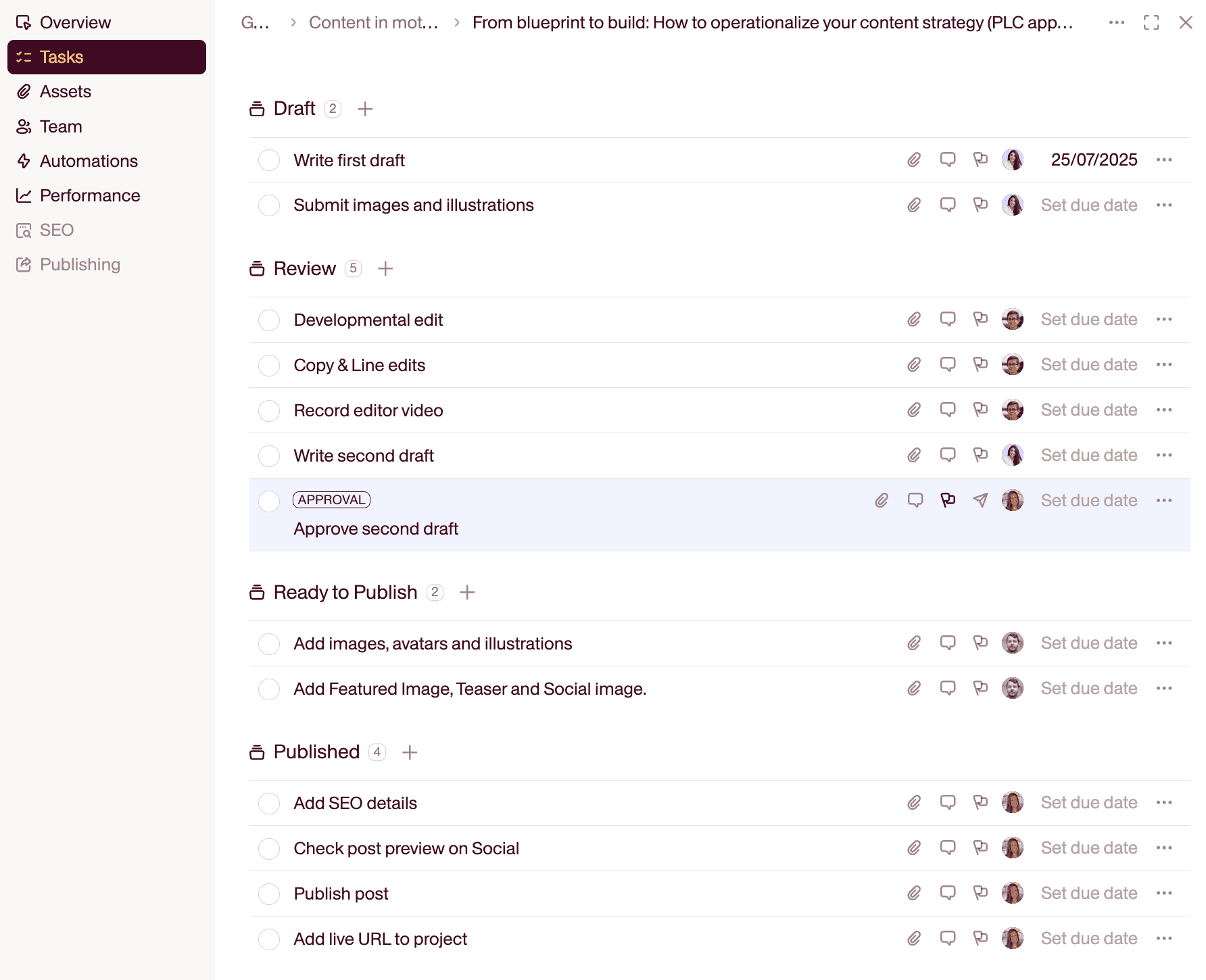
Feedback arrives too late — or all at once
Nothing derails a content timeline like late or conflicting feedback. It triggers a chain reaction — rushed edits, missed handoffs, and slipped launch dates — leaving the team stuck in reactive mode instead of executing smoothly.
The fix is early alignment. Build review checkpoints into the workflow at strategic moments — after the outline, first draft, and before publication. Clarify who reviews what and when, and define the decisions each stakeholder owns.
Use a responsibility assignment (RACI) matrix to map who's responsible for creation, accountable for approval, consulted for expertise, and informed of progress.
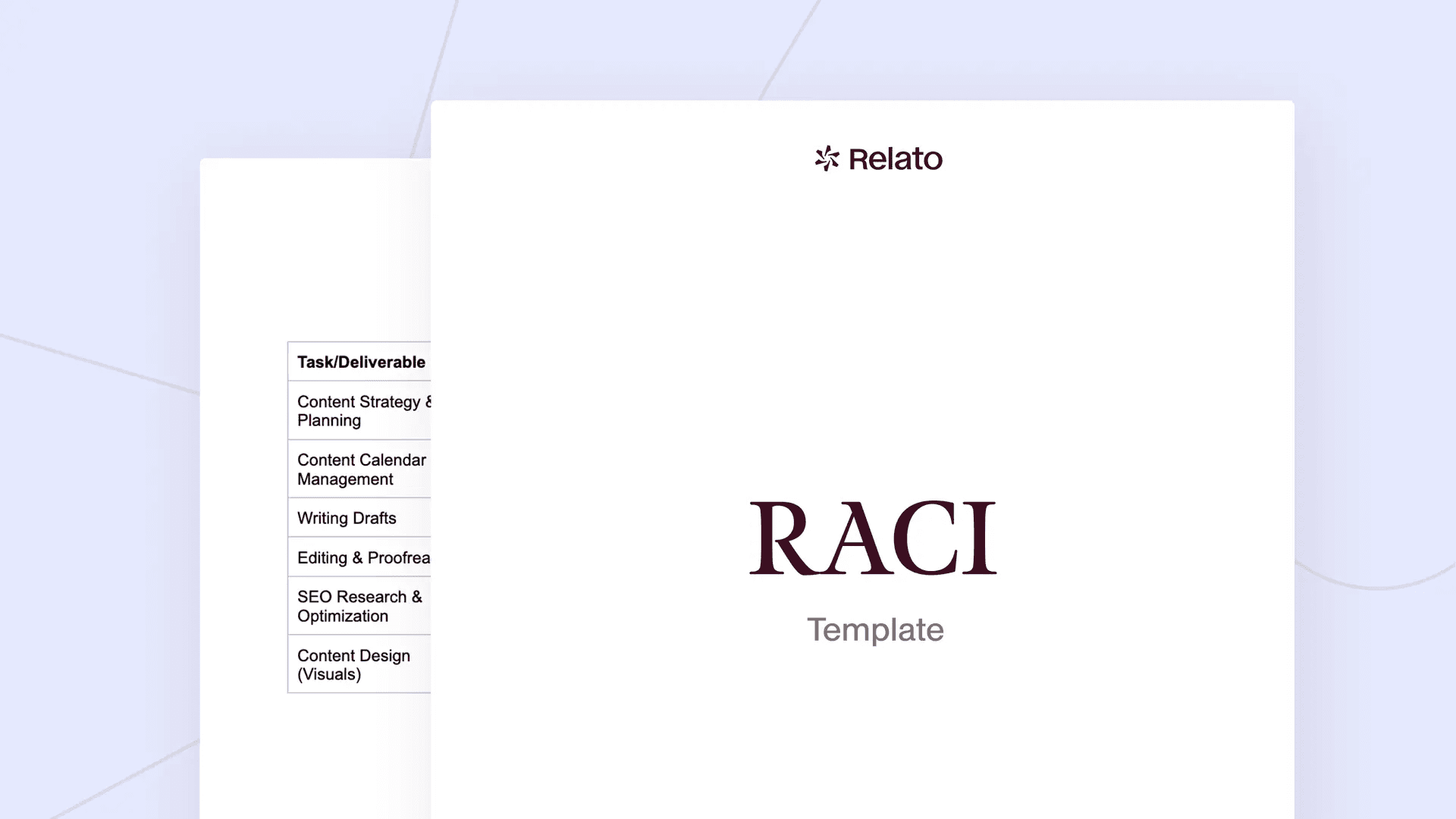
This prevents the all-too-common scenario where either no one reviews or everyone thinks they have veto power.
Everyone's working — just not on the same thing
Teams can stay busy without being productive when everyone's pulled in different directions. Leadership wants more content with fewer resources, AI mandates push for higher volume, and urgent requests scatter your team across disconnected projects.
Chelsea Castle, Head of Content and Brand at Close, sees this disconnect all the time:
“I still see a lot of teams getting hung up in the hamster wheel. With AI, there's a lot of pressure and education needed when we think that we can just use AI to spin up more content. We were already creating a race to the bottom with content quality, and now with AI in the mix, it feels like we are diminishing all of the progress we made in helping people understand how to write for humans."
The problem isn't working on different content types — that's necessary. The issue is when there's no strategic framework connecting these efforts, so you end up with content that checks boxes but doesn't build toward meaningful goals.
This is where operations become strategy. A system that connects individual content pieces to broader campaigns ensures everyone's work builds toward the same goals.
Go from themes to timelines
Big ideas need small steps. Without clear themes, formats, and timelines, your team won’t know what to create — or when. Break big goals into campaign-level themes, then map them to specific content types, owners, and deadlines.
Start with campaign themes or quarterly goals
Start with your quarterly goal, then work backward. If you’re trying to drive adoption for a new product feature, for example, map that to campaign themes, formats, and deadlines.
And be realistic about your team’s capacity. Most content teams are just one to five people, yet they’re managing an average of five content formats at once. That kind of scope makes it easy to overpromise and under-deliver, especially without a workflow that assigns timelines, owners, and review layers.
A strategy that doesn’t account for bandwidth will always break in execution. Build from what’s feasible, then layer in stretch content if time allows.
Once the big-picture goal is clear, break it down:
- What questions is this audience asking?
- What formats are most useful to them?
- Where do they prefer to consume content?
This is where Sam offers a smart operational tactic: “Our content strategy is simple. We write content that answers questions our customers have that our product helps solve.”
“Our content strategy is simple. We write content that answers questions our customers have that our product helps solve.”
To put that into action, his team uses a Core Questions Doc — a spreadsheet that maps user questions to articles and flags which ones need updating or review.
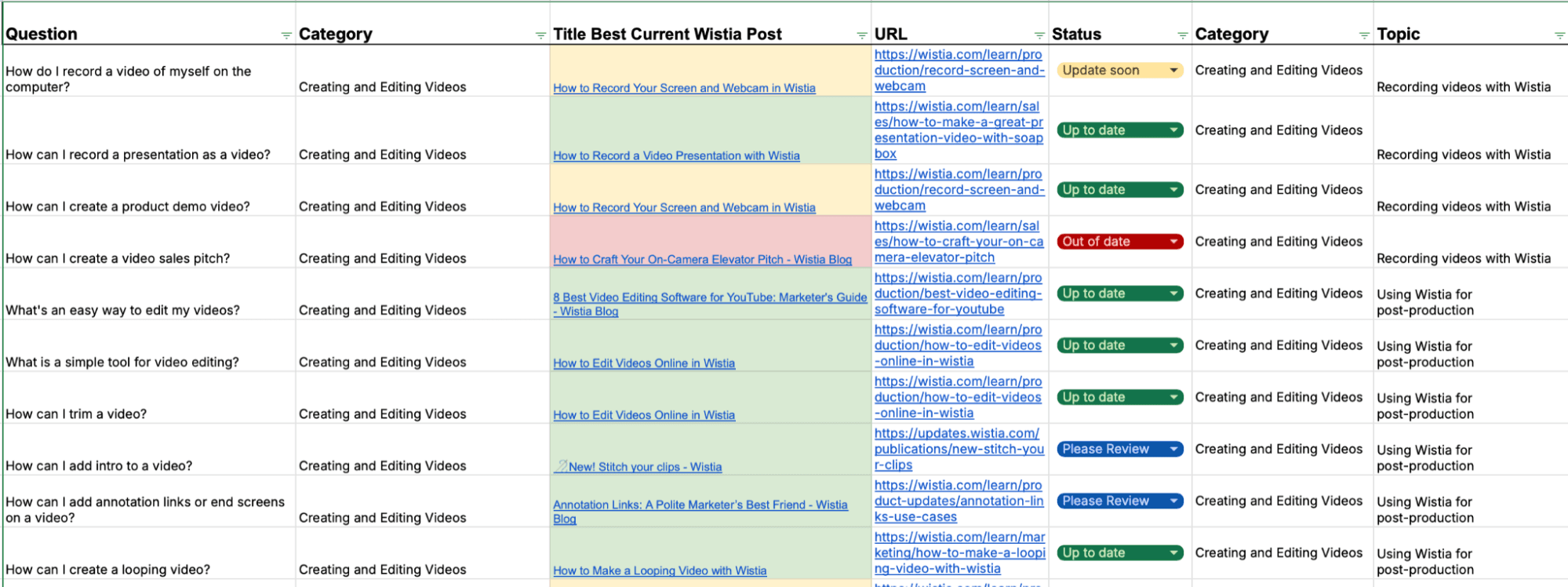
It keeps their library relevant, organized, and tightly connected to customer needs.
Steal this approach: map content ideas to real customer questions aligned with your goals. Then prioritize based on gaps, freshness, and strategic relevance.
Identify content types and channels
Once your campaign theme is set, the next step is figuring out how to deliver it across formats, layers of depth, and the channels where your audience pays attention.
Chelsea organizes her strategy around consistency and visibility: "I organize my content strategy into a few buckets: what is your baseline, your baseline content output, your baseline brand building. So you can show up where your audience hangs out, reinforce your point of view, and increase your touch points."
For example, if your campaign theme is email authentication expertise, your baseline might include weekly LinkedIn posts about deliverability tips, monthly blog posts about authentication best practices, and quarterly webinars with email experts. This baseline layer gives you rhythm. From there, you can build depth.
"Instead of creating something generic for all three audiences - break it into specific pieces for each group," Kasey explains. Here’s how he breaks complex topics into three tiers to match audience needs:
- Basic information (definitions, explainers, how-to content) — for general marketing audiences who need to sound informed in meetings
- Expert insights (more specific, actionable advice) — for email teams who manage authentication but don't need technical implementation details
- Thought leadership (a unique POV or info no one else can provide) — for IT professionals who set up DNS records and configure protocols
Map your campaign theme to these layers, then assign formats: basic explainers become blog posts, expert insights become gated guides, and thought leadership becomes webinars or speaking opportunities.
This structure keeps your campaign cohesive without bottlenecking your team.
Build structure before assigning tasks
Before work begins, lock in the structure:
- What is this piece for?
- Who owns it?
- When is it due?
A clear brief, owner, and timeline prevent mid-project confusion.
Without that structure, teams risk misalignment — trying to speak to multiple audiences in a single piece or drifting away from the original objective.
Jennifer Clark, Content Marketing Lead from Zoom, sees this firsthand when audience focus gets muddled:
“We sometimes run into pushback from internal teams who worry we’re limiting ourselves by not highlighting our enterprise features in SMB campaigns. But we remind them: if we speak clearly to the right audience, the rest will find what they need through other channels.”
“We sometimes run into pushback from internal teams...But we remind them: if we speak clearly to the right audience, the rest will find what they need through other channels.”
It’s a great example of how upfront clarity on audience, messaging, and purpose keeps content sharp and focused. Which helps avoid strategic drift later on.
Build briefs that guide, not confuse
A strong brief connects strategy to execution without limiting creativity. It clarifies who you’re speaking to, what to say, and why it matters, so everyone stays aligned. Here’s what to include, with previews from how we include these elements in our briefs.
Check out our content brief template here.
Clear objective tied to campaign
Every content piece should directly support a broader campaign goal. If your theme is email deliverability expertise, clarify whether this asset is meant to generate leads, nurture existing prospects, or reinforce your authority in the space.

Jennifer underscores the importance of starting with audience clarity:
“Content should always begin by knowing your audience and their challenges. So if we're targeting ITDMs, we work to understand that audience's needs and create campaigns and content that speak to them.”
“Content should always begin by knowing your audience and their challenges.”
When writers know the goal and audience, they can clearly link your product’s features to the problems it solves.
Target audience and stage
Instead of writing for “marketing professionals,” define your target like this: “email marketing managers at B2B SaaS companies struggling with deliverability for the first time.”
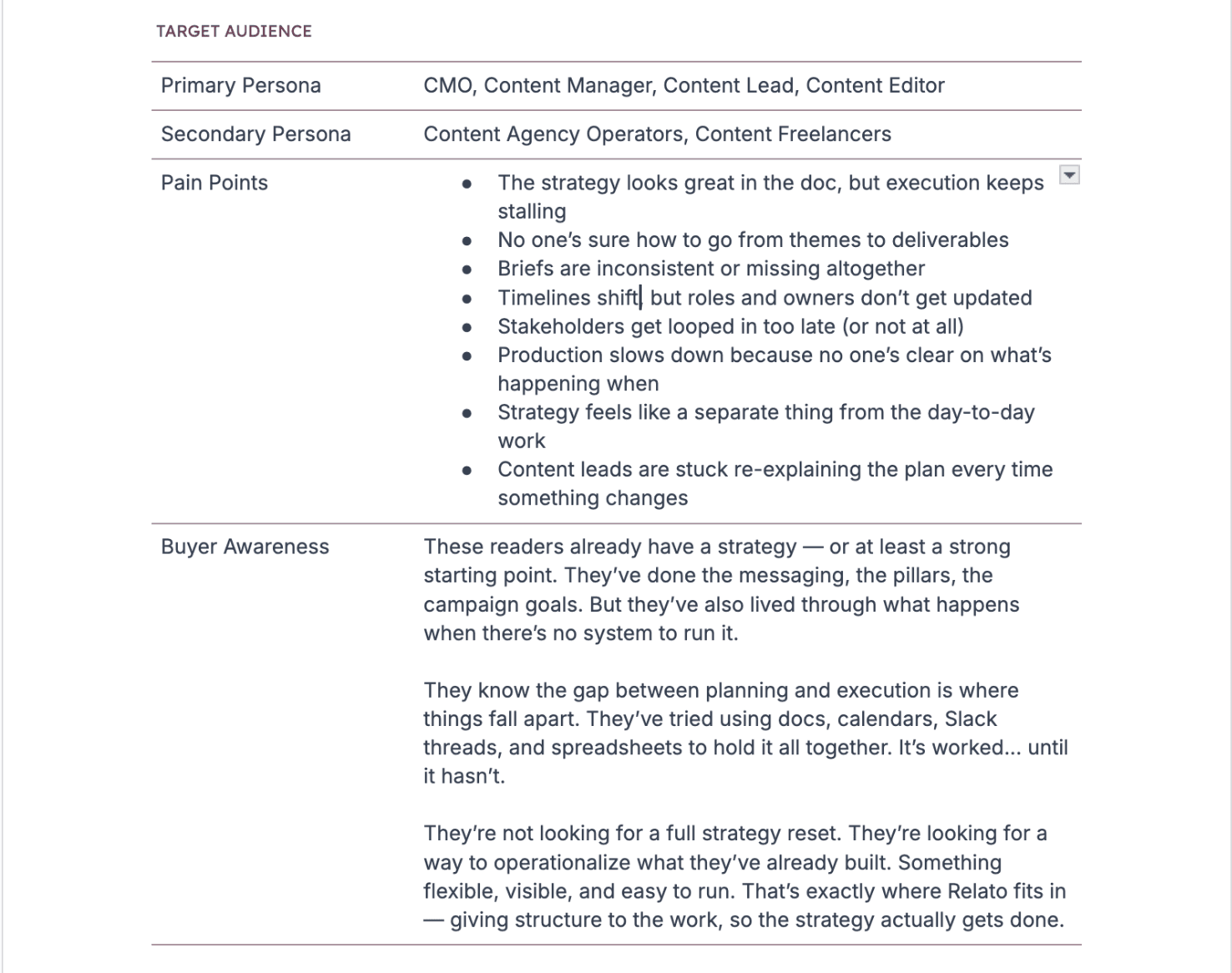
Kasey highlights why this clarity matters, especially when collaborating with subject matter experts:
“Make sure the experts you work with understand the intended audience as well as you do. Are you explaining a complex topic to newbies, or are you writing thought leadership content that their industry peers will consume? There's a big difference.”
“Make sure the experts you work with understand the intended audience as well as you do. Are you explaining a complex topic to newbies, or are you writing thought leadership content that their industry peers will consume? There's a big difference.”
When everyone’s aligned on who the content is for — and what stage of awareness or decision-making they’re in — the insights, tone, and depth all get sharper.
Format, voice, and key points
Spell out the essentials: is this a blog post or a whitepaper? Should it sound like a casual conversation or read like a technical guide? What are the three core takeaways the reader should walk away with?
These elements matter more than you think: 60% of content marketers aren’t confident their content is recognizable by voice and tone alone.
Create clear briefs that define voice, audience, and purpose.
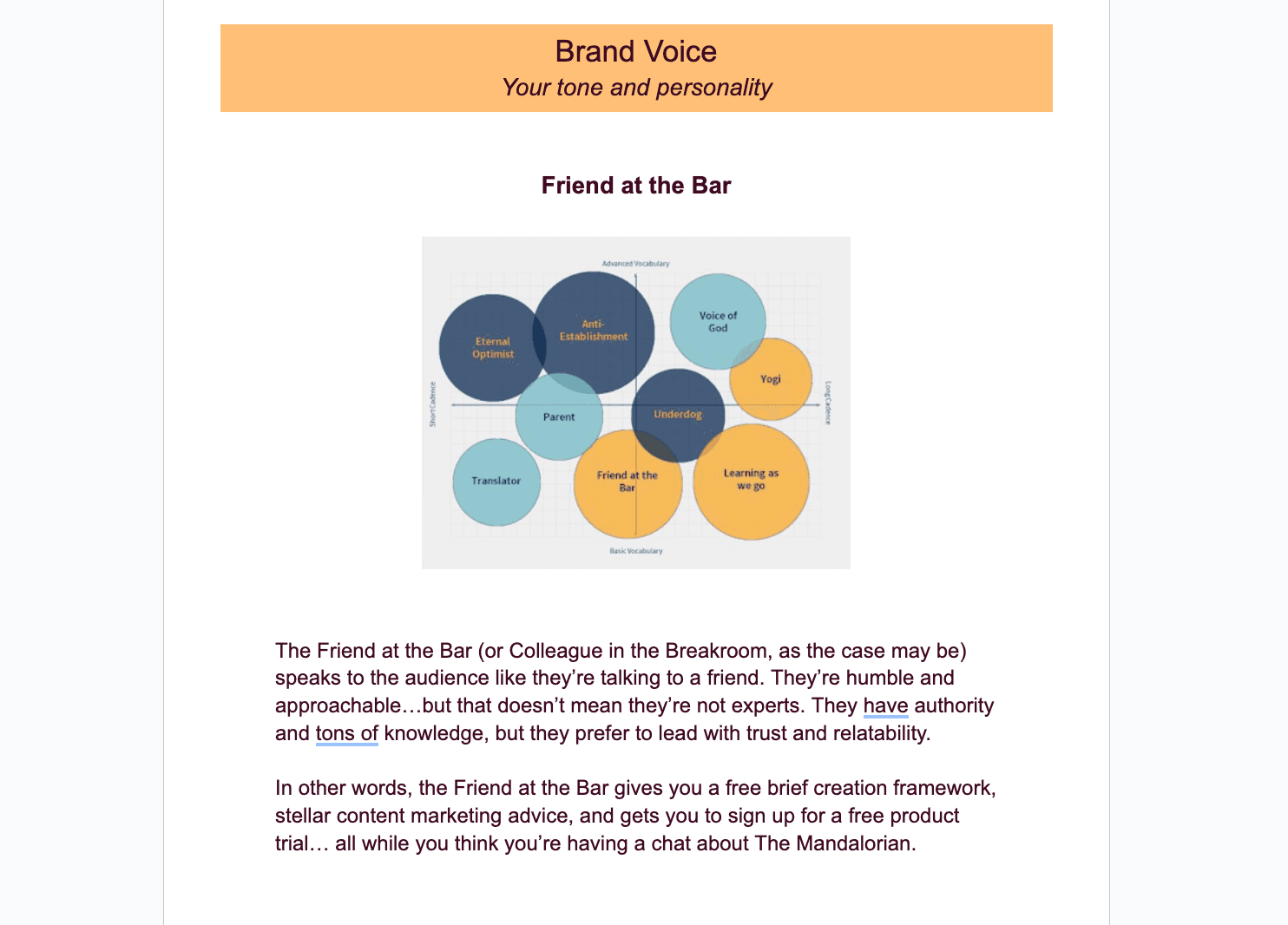
These guidelines help your content sound like you. And when your content speaks with a distinct voice, it becomes instantly recognizable and memorable.
These details keep writers aligned, reducing guesswork, rewrites, and edit rounds.
Links to past work or SME input
Give writers context they can act on. Link to past content that nailed tone or structure, customer interviews, or SME notes. These references help writers echo your brand voice, highlight key product benefits, and reduce revision rounds.
Kasey emphasizes the value of capturing SME input early:
“Keep a record of those calls, emails, and Slack/Teams conversations for review. They help you capture the expert’s voice. They’ll lead to good ideas when you take another look. And you can reuse and repurpose those insights in other projects and marketing channels.”
Create a single source of truth for all your reference materials in Relato. House past content, SME transcripts, and interview notes directly in the app, organize them by collections, and connect them to specific briefs.
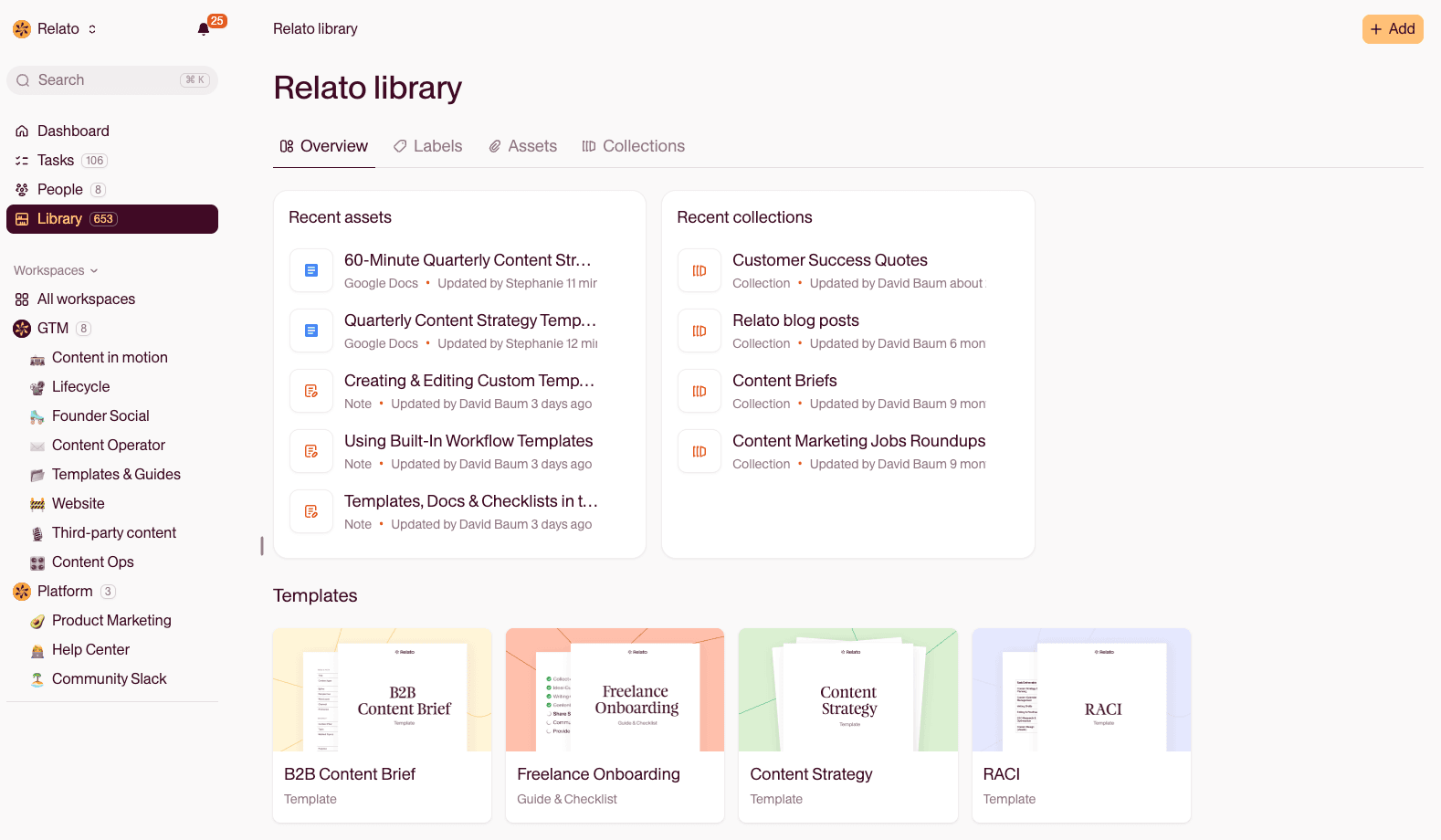
This way, your content producers always have the context they need, right where they’re working.
Assign ownership and define roles early
Clear content ownership prevents delays. When everyone knows their role and deadline, content moves through review without getting stuck.
Who’s writing, reviewing, approving, and publishing?
Instead of assigning broad ownership like "marketing handles the blog post," specify exactly who does what:
- The freelancer writes the draft
- The content strategist approves the structure
- The product manager reviews for accuracy
- The social media manager publishes and promotes
At Zoom, this kind of role clarity is baked into how the team manages content across multiple product lines like Zoom Meetings, Phone, Events, and Webinars.
Jennifer explains:
"We work in a pod model where we assign content strategists and writers to pods based on personas and products.
This allows us to focus on each product almost as its own business unit. We coordinate campaigns in these pods with product marketing, integrated marketing, digital, and social media to plan and promote the assets each quarter."
The pod structure reduces overlap across product lines, keeps messaging consistent, and ensures every campaign has a focused, cross-functional team driving it from start to finish.
What’s the timeline, and where does it live?
A single due date isn’t enough. You need a timeline that maps every step — drafts, reviews, approvals — with buffer time for edits and constructive feedback.
Relato removes the guesswork with pre-built workflows designed for content teams. Each workflow comes with tailored steps, tasks, and approvals based on the type of asset, so you’re not reinventing the process for every blog post, case study, or campaign.
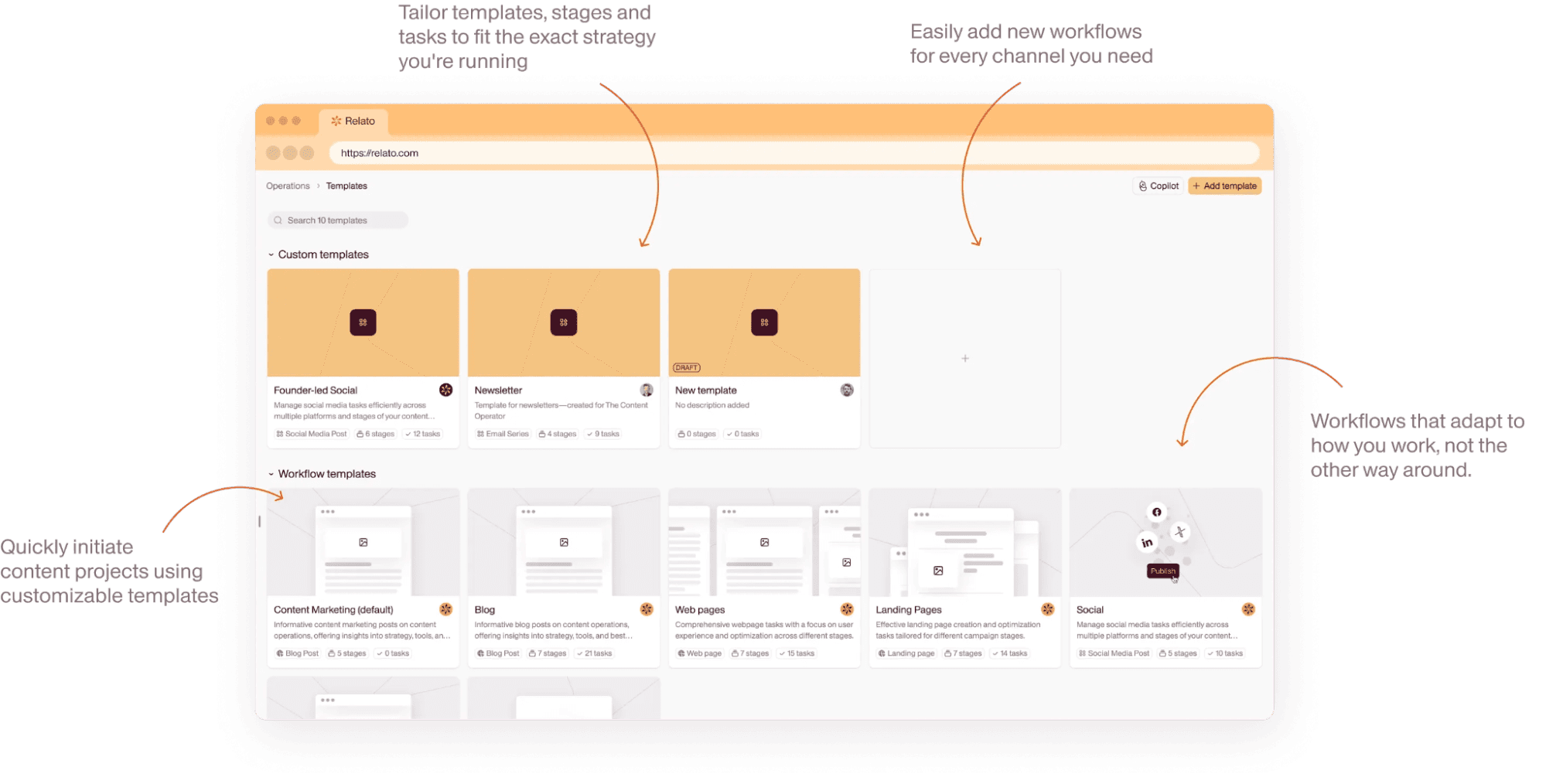
Unlike generic project tools, Relato’s workflows reflect how content production actually works. Writers, editors, and stakeholders know exactly when their input is needed and what’s expected, so nothing stalls and nothing gets missed.
What happens when something shifts?
Deadlines move. Priorities change. The CEO suddenly wants a keynote deck. If ownership is clear from the start, none of this breaks your content system.
Chelsea sums it up:
"If you were aligned at the very beginning, then down the road, anything else shouldn't really cause too many issues or hiccups when you're actually operationalizing on that strategy."
“If you were aligned at the very beginning, then down the road, anything else shouldn't really cause too many issues or hiccups when you're actually operationalizing on that strategy.”
With defined roles, it’s clear who makes the call when things change. The content lead can quickly assess what’s doable, reset deadlines, and keep things moving without confusion or delays.
Without this structure? You get missed deadlines, duplicate work, and endless feedback loops.
Relato’s workflows are fully customizable. Update tasks, roles, and timelines in seconds. When plans shift (and they will), your team stays aligned without chasing updates across spreadsheets or Slack threads.
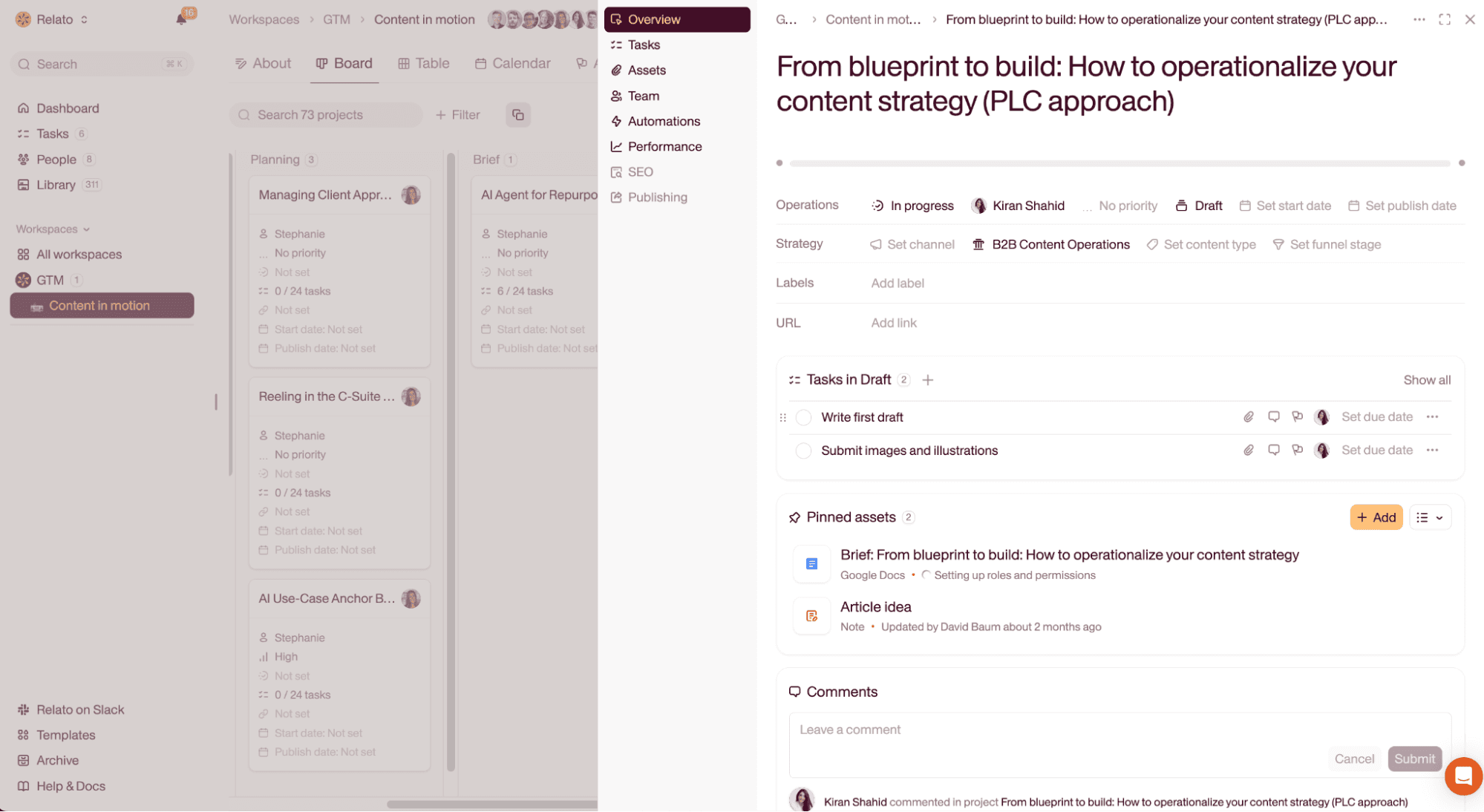
Make workflows shape the strategy
Your production process shapes what content gets made, when it ships, and whether it hits your goals.
Here's how to flip that dynamic and let operations drive better strategy decisions.
Build flexibility into your content calendar
If your workflows are rigid, your strategy gets stale fast. Flexible planning lets you adapt to product changes, adjust timelines, and align formats to support one another without derailing your goals.
At Wistia, Sam deals with this when video production timelines don't align with blog or social content schedules. His approach is to design workflows that reflect reality.
"Your content calendar needs to be flexible enough to accommodate shifts in the product calendar. The amount of time it takes to write a high-performing blog post has increased while the amount of time to make high-performing videos has decreased, so the production gap between video and text is closing."
This approach keeps production moving and creates cohesion across formats so the content strategy stays on track even as timelines shift.
Make content work across teams
Automation also helps your content work harder across teams. We asked Zapier's Content Operations Manager about how they use automation in their own content workflows:
“We have an automation set up that watches for articles published that mention partner apps, and then it collects them, stores them, and once a week, releases a digest in a Slack channel so the partnerships team can see what relevant articles we've published recently. This saves our team a ton of time and manual effort and keeps the partnerships folks from having to search for things when they're reaching out to partners.”
By embedding content into your workflows, each piece becomes a repeatable asset, not just a one-off deliverable.
Use strategy as your decision-making filter
When your workflow includes strategy checkpoints, you don’t have to debate every off-brand request since you’ve already built in the answer.
Chelsea explains it well:
"Your strategy is what you map everything back to. It’s what you use when your CEO is asking you to do something out of left field — you take a step back and say that doesn't align with your strategy."
At Relato, we use these checkpoints internally too. If someone suggests a quick-turn content idea that doesn’t map to our core focus areas, like content operations or thought leadership, we can quickly assess and redirect. Because our strategy lives next to every campaign brief, it’s easy to gut-check decisions before execution begins.
Plan for updates from the start
Strong content compounds, but only if the material stays accurate. When you build maintenance into your workflow upfront, you can double down on high performers instead of scrambling to create from scratch.
Skipping this step often means struggling when product features change or stats go stale. Kasey explains:
“One area where we need to make regular content updates involves pieces that cite our original research. When new findings come out, we want to update both types of content with the fresh data and links to the new report. So, it’s crucial to keep track of all the important pieces that mention last year’s version of the report.”
It’s not just for data-driven content. Jennifer shares how the team handles evergreen blog posts:
“If we write a blog for small businesses needing an AI assistant, we’ll measure it after a while. If it’s successful, we’ll go back and frequently update it versus creating net-new content. This helps us continue link building to newer features without taxing the content writers.”
This proactive maintenance approach becomes even more critical when writing about rapidly changing topics. Janine highlights how Zapier turns maintenance challenges into opportunities:
“We build in regular review cycles to make sure articles are still accurate when features change or apps shut down. But sometimes those changes provide an opportunity for us to step in and offer a solution. For example, when Google Calendar removed SMS notifications, we created a piece showing people how to recreate that with a Zap.”
The fix: During briefing, flag any content that includes time-sensitive data, evolving product features, or original research. That tag becomes your update roadmap later without any audits.
Make your strategy executable
The gap between planning and doing is where most content strategies die. But when you design workflows that connect strategic themes to actual deliverables, execution becomes automatic.
It’s easy to get bogged down in the process instead of focusing on creating great content. Sam puts it perfectly:
"Overall, creating content should be a challenging but fun activity. It should be something where curious people are learning and writing about topics they find interesting. If the process is getting in the way of that enjoyment and turning creatives into checkbox marketers, then the process needs to be fixed."
What makes the difference is building systems that flex as you grow. Janine mentions how Zapier scales without breaking things:
“We are pretty intentional when we set up systems (and we expect to iterate to make them work the way we need them to). We also give everyone the ability to set up their own automated systems to help with the parts of their work where they see the opportunity for more efficiency.”
Instead of drowning your entire content team in spreadsheets and status meetings, Relato removes the friction to streamline your content strategy. Your whole content team gets back to what they love: producing content that reflects your expertise and earns its spot in the buyer’s journey.
The strategy works because the system works. And the work becomes fun again.
Ship your content strategy.
Subscribe to the Relato newsletter for bite-sized ops tips, templates, and real examples to keep content moving and launches on schedule.